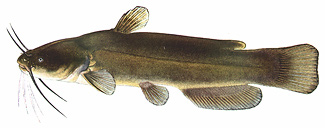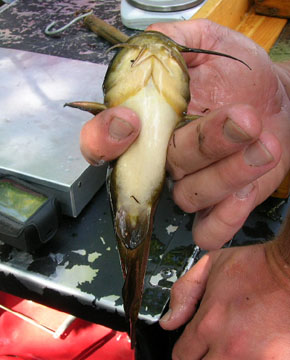Yellow Bullhead
Ameiurus natalis
 Distribution: The yellow bullhead is native to the midwestern and southeastern United States. They were first introduced into the Merrimack River watershed and have now been spread to many coastal rivers.
Distribution: The yellow bullhead is native to the midwestern and southeastern United States. They were first introduced into the Merrimack River watershed and have now been spread to many coastal rivers.
Description: The yellow bullhead is a species of catfish that has a similar appearance to that of the brown bullhead with the exception of two yellow bottom whiskers and a yellowish underbelly.
Species commonly confused with: Brown bullhead, margined madtom

Habitat: Yellow bullhead are habitat generalists, but are most common in lakes, ponds, and slow flowing sections of medium sized to large rivers. In New Hampshire, the yellow bullhead is sometimes found in faster flowing, more riverine habitats than the brown bullhead, but there is much overlap between the two species.
Life History: Yellow bullheads spawn in the spring. Eggs and fry are guarded by both parents in shallow nursery areas with adequate cover. Once hatched, the fry swim in a tight school until they reach about one inch in length. Yellow bullheads are nocturnal, with an omnivorous diet consisting of both dead and living prey. They are similar to brown bullheads in size, reaching lengths of up to 18 inches (457 mm) and weights of 3 pounds (1.4 kg).
Origin: Introduced
Conservation/Management: There are no specific conservation or management objectives for yellow bullhead.



